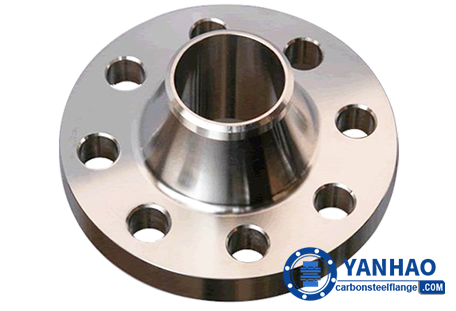What is the difference between ASME B16.47 Series A, Series B flanges?
The standard ASME B16.47 is divided into ASME B16.47 series A and ASME B16.47 series B flange for Blind flange and Weld neck flange. What is the difference between the A-series and the B series in the ASME B16.47 flange standard? How should we choose?
Today, a friend asked about the difference between the A-series and B-series flange standards in the ASME B16.47 flange standard. How should I choose? Friends are welcome to communicate and discuss more~

A table showing the difference between ASME B16.47 Series A and Series B
| ASME/ANSI B16.47 Series A | ASME/ANSI B16.47 Series B | |
| Physical Attributes | Thicker, heavier, stronger, with larger diameter bolting | Lighter, with increased, smaller diameter bolting |
| Types | Weld Neck flanges Blind flanges | Weld Neck flanges Blind flanges |
| Size | 26"- 60" | 26"-60" |
| Pressure | Class 150, 300, 400, 600, & 900 | Class 75, 150, 300, 400, 600, & 900 |
| Application | Used for pipe-to-valve or equipment connections | Used in pipe-to-pipe application |
| Material | carbon, stainless, and other alloy materials | carbon, stainless, and other alloy materials |
| Price | expensive | Cheap |
| Other Names | MSS SP44 | API 605 |
ASME B16.47 Flange
In November of 1980, Subcommittee C of the American Society of Mechanical Engineers (ASME) B16 began work on the B16.47 Large Diameter Steel Flange Standard to standardize dimensions, tolerances, markings, and materials for Nominal Pipe Sizes 26” to 60”.
ASME B16.47 Series A is sourced from MSS SP-44, Prior to this in July of 1952, MSS-SP44 covered 12” thru 60” Nominal Pipe Sizes (NPS), in 150# to 900# pressure ratings in the raised face (RF), flat-faced (FF), and ring type joint (RTJ) facing.
Series B source is based on API 605, The initial draft was developed in December of 1982, and went thru several adjustments before being approved and published in 1990 as Series A (Duplicating MSS-SP44 specification) and Series B (Replacing API-605 specification).
Series B flange was also formerly known as API 605 flange. Term B16.47 or B 16 47 or ANSI B 16 47 are all used interchangeably and refer to the same standard.
The different between ASME B16.47 Series A and Series B
A series are large-diameter flanges, and B series are pipe flanges.
A series: large holes and large bolts, less quantity
B series: small holes and small bolts, large quantity
Generally speaking, ASME B16 47 Series A flanges are much thicker, heavier, and stronger than Series B flanges in the same size and pressure rating thus can withstand more external loading than Series B type.
ASME B16.47 Series B flanges need more but smaller fasteners (bolts & nuts) than Series A flanges and have a smaller bolt circle diameter than that of Series A flanges. The smaller bolt circle diameter results in less flange movement after installation.
Both Series A and Series B standards define weld neck flanges and blind flanges in raised face type (RF) but only Series A defines ring type joint (RTJ) flanges from Class 300 through Class 900 within this standard.
From a commercial point of view, ASME B16.47 Series A flanges are more expensive than ASME B16 47 Series B flanges.
The piping size is the same between the two, and the connection size is different, so you need to choose according to the actual situation.
Generally, more B is used in pipelines. For example, domestic SH3406 and HG20615 are all from ASME B16.47 B (API605).
The selection is mainly based on your own design needs. There is no special regulation to generally choose a small size. After all, the cost is relatively low.
In Conclusion: ASME B 16.47 Series A and Series B flanges are for large diameter applications for piping projects from 26” thru 60”. Both Series can be manufactured using carbon, stainless, and other alloy materials. Series A is a carryover from MSS SP44 and Series B from API 605, thus creating a more uniform standardization for the industry thru ASME B16.47.
How should I choose ASME B16.47 Series A and Series B?
Price points for Series A flanges tend to be more expensive due to increased steel weight, Application of Series A flanges are normally used for industrial connectors such as valves, pumps, and pipeline separations.
whereas Series B consumes less steel weight, therefore, reducing cost. Series B flanges are commonly used in pipeline applications.
Conclusions: Sizes 26" and bigger are covered by B16.47 series A or series B for weld neck and blind flanges. Series A flange is heavier, thicker, and costs more whereas series B flange has more bolt holes and is lighter cheaper than series A. API605 flange and series B flanges are the same things.
Most piping users or designers may choose Series A flanges for the new pipeline or equipment. But if you are doing some refurbishment, replacement job, or non-critical piping design, Series B flanges are more popular.
If you need flanges, welcome to contact us, we can provide you with high-quality standard and customized flanges.
Phone: 0086-153 0317 8205
Email: sales@yanhaocn.com

